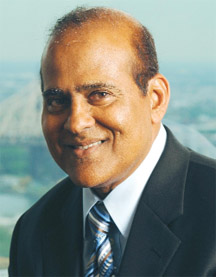Former Auditor General Anand Goolsarran says that the PPP/C government has made the National Industrial and Commercial Investments Limited (NICIL) into a parallel treasury, retaining and using funds meant for the Consolidated Fund at the discretion of its directors in violation of the Constitution.
Goolsarran also says that sales of assets vested in NICIL resulted in huge windfall gains, since there were often no matching costs against which profit could be measured and that NICIL saw a mark up of 900 percent from 2002 to 2010. Writing in his Stabroek News, published on Monday, Goolsarran said that in order to regularise matters at NICIL, it must be realigned to what it was prior to 2002 or alternatively its operations must be wound up. He recommended too that it must be ascertained how much should have been paid over to the Consolidated Fund from 2002 to present, against what has actually been paid.

He is also recommending an investigation into what happened with the difference and appropriate disciplinary action against the concerned officials, if it can be established in a court of law that there has been a violation of articles 216 and 217 of the Constitution.
The two articles provide for the establishment of the Consolidated Fund (Article 216) and set out instances for withdrawals from it and other public funds (Article 217).
Goolsarran said that for the 2002 and 2003 audited accounts, there were adjustments of $1.313 billion and $4.159 billion to the income statement described as “Recognition of assets understated.” He explained that this implies that there were significant omissions in the audited accounts for 2001 and 2002.
“However, the notes to the financial statements for 2002 provided little clarification while for 2003, it was stated that BIDCO, which was previously recorded at a nominal amount, was wound up and as a consequence LINMINE, BERMINE and 49 percent of Surapana were vested in NICIL,” he said.
He added that the notes to the 2004 accounts repeated those of 2003, with the addition that LINMINE was wound up and specific assets vested in NICIL. “However, a negative adjustment of $1.949 billion was made in NICIL’s income statement for 2004 but no further explanation was given. It would appear that the negative adjustment of $1.949 billion was a downward adjustment to the two previous years’ upward adjustments,” he said.
According to Goolsarran, there were therefore fundamental errors in the audited accounts of 2001, 2002 and 2003 which NICIL sought to rectify in the following year. “These errors should have been picked up during the course of the audit and brought to NICIL’s attention so that the necessary corrections could be made to the accounts of the year in question,” he said.
“In addition, the rationale for adjusting the recorded income because of the ‘recognition of assets understated’ is not clear. If a fundamental error has been made in the previous year’s financial statements, any adjustment should not affect the results of operation of the current year.
Rather, there should have been a statement of prior year adjustments and the comparative figures in the financial statements re-stated,” he explained.
Goolsarran explained that there is an accounting convention called the matching concept, whereby revenue is matched with the cost of earning it, to arrive at a profit. He said too that the latter is really the mark-up, which, for many businesses, varies from roughly 15 to 25 percent, depending on the kind of nature of the business. “NICIL’s mark-up for the years 2002 to 2010 relating to the disposal of assets, averaged over 300 per cent! This was mainly due to the nominal values assigned to the properties vested in it. It is also testimony to the flawed accounting arrangements,” he said.
He added that the audited accounts of NICIL for the years 2002 to 2010 showed that dividends received from public corporations as well as from other investments, amounted to $8.634 billion. “NICIL also showed this amount as its revenue but there were no matching costs, hence another source of windfall gain. Taking this into account, NICIL’s mark-up over the ten year period was over 900 per cent i.e. its revenue was more than nine times its operating costs,” he said.





